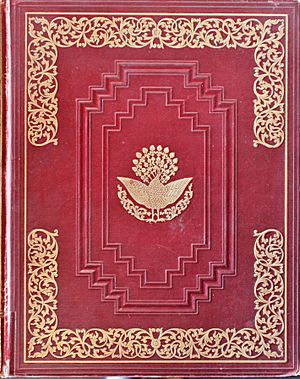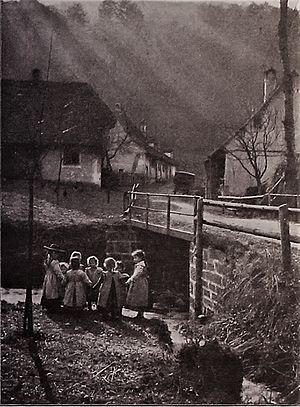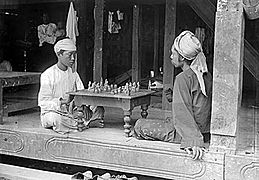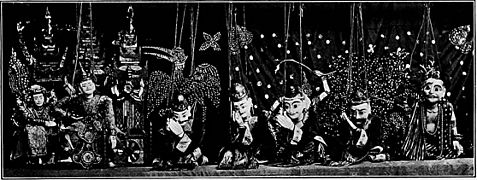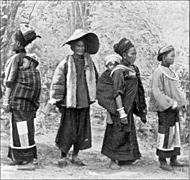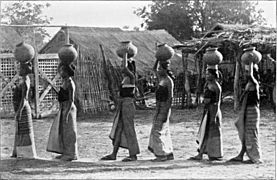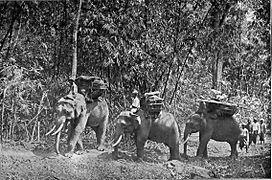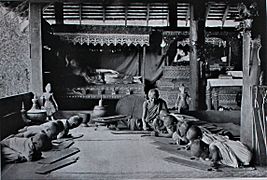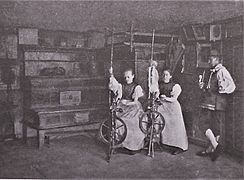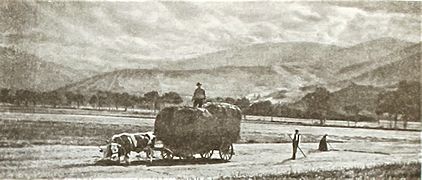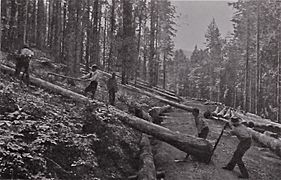Max Henry Ferrars facts for kids
Quick facts for kids
Max Henry Ferrars
|
|
|---|---|
| Born | 28 October 1846 Killucan, Ireland
|
| Died | 17 February 1933 (aged 86) Freiburg i. Br., Germany
|
| Nationality | British |
| Education | Trinity College Dublin |
| Alma mater | Royal Saxon Academy of Forestry, Kingdom of Saxony |
| Occupation | colonial officer, author, photographer and university lecturer |
| Known for | ethnographical accounts and photographs of 19th-century Burma |
| Spouse(s) | Bertha Ferrars |
Max Henry Ferrars (born October 28, 1846 – died February 7, 1933) was a British officer, writer, photographer, and teacher. He worked mostly in British Burma (now Myanmar) and later in Freiburg, Germany. He spent 25 years working for the government in colonial Burma. He helped manage forests and worked in other public jobs.
With his wife Bertha, he wrote and took pictures for a big book called Burma. It showed the different cultures and people of Burma in 1900. Years later, his work was recognized by groups like the Royal Geographical Society. A museum in Freiburg, Germany, also honored him. He had given them many items from Burmese culture.
In 2011, a collection of articles about the Bamar people praised his book. They said its many photos on all kinds of topics were "unequalled."
Contents
Early Life and Education
Max Henry Ferrars was born on October 28, 1846, in Killucan, Ireland. His father was an Irish church leader, and his mother was German. He studied at Trinity College Dublin. In 1870, he moved to Germany. There, he studied forestry at the Royal Saxon Academy of Forestry in Tharandt. This school was famous for teaching forestry as a science. It covered topics like measuring forests, managing land, biology, and money matters.
Working in British Burma
After finishing his studies in 1871, Ferrars moved to British Burma. He first worked as a forest manager. Later, he became an inspector for schools and educational services. The British had taken control of parts of Burma in the 1850s. By 1885, they had taken over all of Burma.
Forestry was very important for the British economy in Burma. They harvested and exported valuable wood like teak. A German expert named Dietrich Brandis helped set up a system. This system made sure teak forests were used wisely and could grow back.
Ferrars also joined a group that wanted to stop the opium trade in Burma. He wrote about the bad effects of opium. Because of this, he had disagreements with the British government. He had to leave his jobs in 1896 when he was 50 years old.
The Book Burma
Max and his wife Bertha Ferrars (born November 17, 1845 – died 1937) knew the Burmese language well. They traveled widely across the country. In 1900, they published their book, Burma. This book had detailed descriptions of different ethnic groups and their cultures. It also included 455 black-and-white photos they took in the 1890s.
The book Burma tells stories and shows pictures of people's lives. It covers childhood, growing up, and different jobs. It also talks about various ethnic groups like the Shan and Karen. There are chapters on history, government, and celebrations. The book ends with information about old age and funeral customs.
The Ferrars took photos of people working or celebrating. They also captured popular sports like boat races and the Burmese form of chess, called Sittuyin. The book was so popular that a second edition came out in 1901. It was even reprinted in 1996.
Life in Germany
In 1896, the Ferrars moved back to Europe. They settled in Freiburg, a university town in southern Germany. Max Ferrars joined a committee for the city's Museum for Natural Science and Ethnology. He shared his knowledge of Burmese culture. He also gave many items from his collection to the museum. This made him one of the museum's first big supporters.
His collection is now a main part of the museum's items from Myanmar. It includes over 100 pieces. Among them are 28 Burmese marionettes, beautiful lacquerware, and parts of a wooden door from a Buddhist monastery.
From 1899, Ferrars taught English at the University of Freiburg. He also wrote textbooks for students learning English. He even helped translate a book about church music.
Photography in Germany
Ferrars continued his travels and photography in Germany. One of his photos, showing girls in a Black Forest village, was in a 1905 book called Art in Photography. In the same year, he contributed photos of the Black Forest to a book of poems. The poems were about the lives of farmers and their families. Ferrars' pictures showed scenes like harvesting, cutting trees, and making charcoal.
He also worked in the university's photography lab. In 1911, he won a photography award from a local railway company. In 1901, Ferrars had published a guide on photography. By 1926, a newspaper called him "a pioneer and innovator of landscape photography."
During World War I, it was hard for Ferrars to be a British teacher in Germany. But the university supported him. He kept his job until he officially retired in 1921. Max Ferrars died on February 7, 1933, in Freiburg. This was two years after he and his wife celebrated their 60th wedding anniversary.
Gallery
British-Burma, circa 1890s
Black Forest, circa 1896–1905
Selected Publications
- Max and Bertha Ferrars: Burma. 2nd ed. (1901), Sampson Low Marston & Co Limited, London, Great Britain (pdf).
- Max and Bertha Ferrars: Burma. (1996) AVA Pub. House, Bangkok, Thailand, ISBN: 974-89409-7-7, .
See also
Other important photographers of the 19th century in British Burma:
- John McCosh
- Linnaeus Tripe
- Willoughby Wallace Hooper
- Philip Adolphe Klier
- Felice Beato


